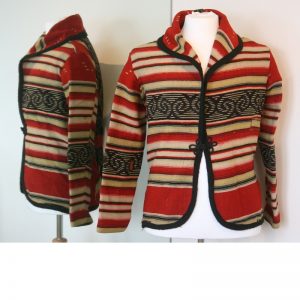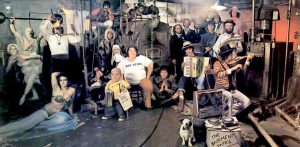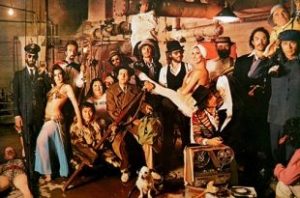Patrick Roefflaer
The Basement Tapes…
- Released January 17, 1975
- Photographer Reid Miles
- Liner Notes Greil Marcus
- Design Consultant Bob Cato
Throughout Summer and Fall of 1967, Bob Dylan and the musicians that later would call themselves The Band, recorded more than hundred songs during informal sessions in West Saugerties, New York. Because most of these recording took place in the cellar of the house called Big Pink, the sessions were dubbed The Basement Tapes.
“We never thought that the public was ever going to hear any of this,” Robbie Robertson said to Uncut in 2016. “It was specifically a songwriting thing, Bob wanted to put down songs for other people to record. We’d lay down a song and he’d say, “Oh, that would be a good one for Ferlin Husky,” or, “Ah, I dunno, maybe Ramblin’ Jack Elliott might be able to get into that.” It was a random, fun thing.”
However, in January 1975, Dylan unexpectedly gave permission for the release of a selection of the recordings. Robbie Robertson was appointed to make a selection of the songs, and worked on them with engineer Rob Fraboni.
Because no photographs exist of Bob Dylan with The Band from the period the recordings were made, a new portrait was needed for the sleeve. Robertson felt that the sleeve of Underground, an 1967 album by Thelonious Monk, had the right kind of vibe. The art-director of that Grammy Award album was John Berg, who had done much of Dylan’s albums and the photographer was Reid Miles (1927-1993).
Reid Miles
When around 1955, the modern jazz label Blue Note started to release their recordings on 12″ LPs, they needed someone to design album covers. Producer and photographer Francis Wolff found Esquire magazine journalist, Reid Miles, who had studied creative design. Although the budgets were small, he created a “hip” brand identity for the label, working with Wolff’s photographs or just “some outrageous graphics!”, as he would put it. Blue Note became the epitome of modern, cool and progressive and Miles Reid one of the earliest album cover designers to take note of.
In the sixties Reid became interested in photography himself, and excelled in that too – as can be seen on the sleeve of Underground. Robertson contacted Miles and told him what he needed.
Reid found the perfect spot for the Basement Tapes shoot in the cellar of the Hollywood YMCA, at the corner of Schrader and Selma. The boiler room, with pipes and mechanical gear all around provided the right look.
The idea was to gather the musicians involved, plus a Fellini like cast of characters suggested by the album’s songs; an Eskimo, the fat lady (with a Mrs Henry T-shirt), a ballerina, a nun, a circus strongman…
As nowhere is mentioned who is who, speculations that people as Neil Young, Ringo Starr and Todd Rundgren are among those involved.
None of them are.
The dwarf, representing Tiny Montgomery, is the actor Angelo Rossitto – famous from Freaks (1932), Mad Max Beyond Thunderdome (1985) and Tom Waits’ Swordfishtrombones (1983).
Here are the characters from this front side of the outer sleeve: mostly musicians + friends
- David Blue (cross legged, with bowler hat)
- Levon Helm, ready for the million dollar bash
- Photographer John Scheele (with hair pulled back + moustache )
- Richard Manual (in Royal Air Force uniform)
- (The Band’s equipment manager) Bill Scheele (in the hat and shades, with a beard)
- Robbie Robertson (in Red Army uniform)
- unknown
- Garth Hudson (with tuba)
- (recording engineer) Ed Anderson (in drag)
- Bob Dylan (with mandolin)
- Rick Danko, with accordion
- dog
Some friends came along for the event: John and Bill Scheele. Bill is equipment manager for The Band, while his brother John documented Dylans’ 1974 reunion tour as photographer. There’s David Blue and Bob Neuwirth.
The “man in drag” at upper right is recording engineer Ed Anderson and Quinn the Eskimo is William David “Charlie” Chin, who’s band Cat Mother & The All Night Newsboys opened for The Band at their first NYC appearance at Fillmore East, in 1969.
John Schleese’s recollected in 2011 to Jim Linderman: “That was a most surreal day: No cameras were ever allowed back then, so this was a conscious effort to evoke the spirit of those sessions. It brought out a mischievous side of Bob Dylan – how he could put on a hat or costume and assume a new identity. In hindsight, that’s a hallmark of his songs and creative work. […]
We started up in a bright room with pool tables to get dressed and ready.”
In a interview to Carol Caffin (published in BandBites, Volume II, No. 2, 2008), John Schleese explained that “Reid had brought in racks of clothes, a pre-fitted selection like you’d do for a casting call, to have pieces ready that would fit Bob or one of the other guys. I know there had to be some special requests because Ed Anderson, who was one of the team by then, was dressed up as a pageant queen. It was a lot of fun, because Ed’s tall and gangly and does not make a very attractive girl. [laughs]”
Bob switched into a red and white striped jacket with a black and grey swirl pattern in bands across the arms and chest. The jacket is made from a Cheumash Indian blanket, which he borrowed from a female friend. In 2012 she offered the jacket to be sold through PFC Auctions. She provided a letter of provenance, in which she describes her relationship with the songwriter. In the letter she explained that the jacket “…was a little too small for him. Whilst wearing the jacket Dylan split the back and arm open but this has since been stitched.”
 “They all tried stuff on upstairs”, John continues, “When we went downstairs, I didn’t take a lot of pictures or intrude into the session, because it was Reid’s photo shoot. I only took a few snapshots of them getting ready, kind of documentary shooting. A few pictures show Bob posing people, moving them around in the shot. Reid had roughed out the basic composition, but Bob helped everyone strike their poses, adding to the surrealism.“
“They all tried stuff on upstairs”, John continues, “When we went downstairs, I didn’t take a lot of pictures or intrude into the session, because it was Reid’s photo shoot. I only took a few snapshots of them getting ready, kind of documentary shooting. A few pictures show Bob posing people, moving them around in the shot. Reid had roughed out the basic composition, but Bob helped everyone strike their poses, adding to the surrealism.“
Once Miles had chosen the photo’s he felt were best to use for the artwork, he destroyed the outtakes. “He would have picked his best transparencies”, explained John Schleese, “in this case, color slides, and submitted them to Columbia. He’d reduce any second-guessing by basically saying “not only are these the best shots, they’re the only shots.”
Bob Cato put one photo on the outside of the fold-out sleeve, with Bob right in the middle of the front, surrounded with the members of the band and the song’s characters on the back. There’s no typography on the outer sleeve. The album’s title is written on a cardboard box right at the front.
The other photo is used on the inner sleeve, next to liner notes provided by Greil Marcus. The text offers a scholarly, if somewhat perplexing analysis, framing the songs in a historical context.
Here’s a who is who of the people involved in the photo shoot, clockwise from left.
back side of the outer sleeve: mostly actors
- Ballerina
- Strongman
- Sword swallower
- Bob Neuwirth (in red shirt)
- William David “Charlie” Chin, as Quinn the eskimo
- Nun
- The fat lady
- Angelo Rossitto as Tiny Montgomery
- Sleeping clown
- Belly dancer
 ”It really captured, in my opinion and in everybody who was there, a little bit of the spirit of what “The Basement Tapes” was like – that carnival atmosphere,” reminisced John Schleese in 2014, “The vibe of this shoot felt a lot like what came to pass in the Rolling Thunder Revue. Bob had makeup on, put on a whiteface. People dropped in and dropped out. He really loosened up in terms of his stage persona. But this has always been an element of Bob Dylan in his album photographs and in the way he poses with the hat, with the mask. On the ’74 tour, we had masks there every night. They didn’t wear them, though. But this was really kind of looser.”
”It really captured, in my opinion and in everybody who was there, a little bit of the spirit of what “The Basement Tapes” was like – that carnival atmosphere,” reminisced John Schleese in 2014, “The vibe of this shoot felt a lot like what came to pass in the Rolling Thunder Revue. Bob had makeup on, put on a whiteface. People dropped in and dropped out. He really loosened up in terms of his stage persona. But this has always been an element of Bob Dylan in his album photographs and in the way he poses with the hat, with the mask. On the ’74 tour, we had masks there every night. They didn’t wear them, though. But this was really kind of looser.”



Very interesting!
Great work Patrick – thanks!
That was an edification needed for a more complete appreciation around The Basement Tapes.
Merci
“Its A Man’ World I” by Pauling Boty (the Rose) shows Thelonus Monk